The feline blood film
- PMID: 28438085
- PMCID: PMC10816527
- DOI: 10.1177/1098612X17706466
The feline blood film
Abstract
Practical relevance: Many veterinary practices have invested in quality automated hematology instruments for use in-house. However, regardless of the specific choice of analyzer, there are important hematology findings that can only be determined by microscopic examination of stained blood films. For this reason, and also for the purpose of quality control for the analyzer, a quick blood film review should be performed alongside every automated complete blood count. Even those practices that submit their blood samples to outside diagnostic laboratories for evaluation, still require the capability to examine stained blood films in emergency situations. Series outline: This is the first of a two-part article series that aims to familiarize the practitioner with normal findings on feline blood films, with a particular focus on unique features in the cat, as well as to assist with interpretation of common abnormalities. Part 1 focuses on how to prepare and examine blood films in order to maximize the reliability of the information they convey, and describes the morphology of feline erythrocytes in health and disease. Evidence base: The information and guidance offered is based on the published literature and the author's own extensive clinical pathology research.
Conflict of interest statement
The author declared no potential conflicts of interest with respect to the research, authorship, and/or publication of this article.
Figures









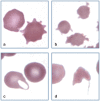
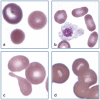










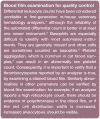
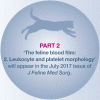

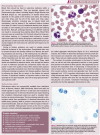



Similar articles
-
The feline blood film.J Feline Med Surg. 2017 Jul;19(7):747-757. doi: 10.1177/1098612X17706471. J Feline Med Surg. 2017. PMID: 28592222 Free PMC article.
-
Hematology without the numbers: in-clinic blood film evaluation.Vet Clin North Am Small Anim Pract. 2007 Mar;37(2):245-66, vi. doi: 10.1016/j.cvsm.2006.10.002. Vet Clin North Am Small Anim Pract. 2007. PMID: 17336674 Review.
-
Evaluation of the impedance analyzer PocH-100iV Diff for analysis of canine and feline blood.Vet Clin Pathol. 2012 Jun;41(2):194-206. doi: 10.1111/j.1939-165X.2012.00405.x. Epub 2012 Feb 10. Vet Clin Pathol. 2012. PMID: 22324888
-
Evaluation of the automated hematology analyzer Sysmex XT-2000iV™ compared to the ADVIA® 2120 for its use in dogs, cats, and horses: Part I--precision, linearity, and accuracy of complete blood cell count.J Vet Diagn Invest. 2011 Nov;23(6):1168-80. doi: 10.1177/1040638711425572. J Vet Diagn Invest. 2011. PMID: 22362798
-
Blood components. Collection, processing, and storage.Vet Clin North Am Small Anim Pract. 1995 Nov;25(6):1245-61. doi: 10.1016/s0195-5616(95)50152-4. Vet Clin North Am Small Anim Pract. 1995. PMID: 8619264 Review.
Cited by
-
Feline non-regenerative anemia: Diagnostic and treatment recommendations.J Feline Med Surg. 2019 Jul;21(7):615-631. doi: 10.1177/1098612X19856178. J Feline Med Surg. 2019. PMID: 31234748 Free PMC article.
-
Regenerative anemia identification in cats: Red blood cell indices or morphology, what to use?Vet World. 2024 Jul;17(7):1591-1595. doi: 10.14202/vetworld.2024.1591-1595. Epub 2024 Jul 24. Vet World. 2024. PMID: 39185061 Free PMC article.
-
Diagnostic bone marrow sampling in cats.J Feline Med Surg. 2017 Jul;19(7):759-767. doi: 10.1177/1098612X17714356. J Feline Med Surg. 2017. PMID: 28592225 Free PMC article. Review.
-
Molecular Detection of Vector-Borne Pathogens and Their Association with Feline Immunodeficiency Virus and Feline Leukemia Virus in Cats from Northeastern Thailand.Animals (Basel). 2025 Jul 12;15(14):2065. doi: 10.3390/ani15142065. Animals (Basel). 2025. PMID: 40723527 Free PMC article.
-
Heinz body-related interference with leukocyte and erythrocyte variables obtained by an automated hematology analyzer in cats.J Vet Diagn Invest. 2019 Sep;31(5):704-713. doi: 10.1177/1040638719863088. Epub 2019 Jul 10. J Vet Diagn Invest. 2019. PMID: 31291839 Free PMC article.
References
-
- Harvey JW. Veterinary hematology. A diagnostic guide and color atlas. St Louis, Mo: Elsevier Saunders, 2012.
-
- Mitzner BT. Why automated differentials fall short. J Am Anim Hosp Assoc 2001; 37: 117–118. - PubMed
-
- Bain BJ. Diagnosis from the blood smear. N Engl J Med 2005; 353: 498–507. - PubMed
-
- Welles EG, Hall AS, Carpenter DM. Canine complete blood counts: a comparison of four in-office instruments with the ADVIA 120 and manual differential counts. Vet Clin Pathol 2009; 38: 20–29. - PubMed
Publication types
MeSH terms
LinkOut - more resources
Full Text Sources
Other Literature Sources
Medical
Miscellaneous

